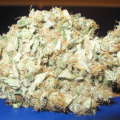

Welcome to the Growery Message Board! You are experiencing a small sample of what the site has to offer. Please login or register to post messages and view our exclusive members-only content. You'll gain access to additional forums, file attachments, board customizations, encrypted private messages, and much more!
|
 Some of these posts are very old and might contain outdated information. You may wish to search for newer posts instead. Some of these posts are very old and might contain outdated information. You may wish to search for newer posts instead.
|
 Inbred_gimp Inbred_gimp
Herb Connesuir
 


Registered: 10/07/09
Posts: 1,115
Loc: Beyond the wall of sleep
Last seen: 6 years, 8 months
|
 Cation Exchange Capacity, pH Cation Exchange Capacity, pH 
#424853 - 05/27/10 10:28 PM (14 years, 10 months ago) |
|
|
Of growing mediums, water Ec
Discuss.
I mainly want to discuss ph changes with temperature, anion and cation balancing to maintain stable pH
--------------------

|
 Harry_Ba11sach Harry_Ba11sach
cannoisseur



Registered: 04/20/08
Posts: 11,753
Loc: Nepal 

|
 Re: Cation Exchange Capacity, pH Re: Cation Exchange Capacity, pH  [Re: Inbred_gimp] [Re: Inbred_gimp]
#424896 - 05/27/10 11:36 PM (14 years, 10 months ago) |
|
|
Wow can you narrow it down a little bit please? I wrote a 25 page dissertation covering just CEC for loamy agricultural soils. You need to pick a more specific topic if you want me to chime in with anything helpful, I had an aneurysm just trying to figure out where to start on this post.
--------------------

|
 Crusty Ass Bastard Crusty Ass Bastard
Pheno Hunting


Registered: 08/02/09
Posts: 786
Last seen: 14 years, 2 months

|
 Re: Cation Exchange Capacity, pH Re: Cation Exchange Capacity, pH  [Re: Harry_Ba11sach] [Re: Harry_Ba11sach]
#424960 - 05/28/10 07:48 AM (14 years, 10 months ago) |
|
|
You guys know I'm a coco fanboy and CEC is most of the reason. Can't think of anything to add to these:
Quote:
Typically, the higher the CEC, the greater the ability of the growth medium to retain nutrients against leaching during irrigation and serve as a buffer from abrupt fluctuations in soil salinity and pH.
Quote:
A high cationic exchange capacity (CEC) is one of the unique properties of coir. The cellulose of coir can draw these cations out of solution, trapping them in the coir until there are appropriate pH changes, or by other influences such as root absorption of the elements.
Quote:
Coir is essentially cellulose and lignins, but these are richly electronegative molecules that will “trap” any positively charged atoms that are in solution. After some time absorbing nutrients, this cation-trapping ability of coir, also called cation exchange capacity (CEC), becomes saturated, since the coir’s cellulose has a limit or “capacity” for how many cations it can hold at any given pH. The adsorptive capacity of coir is high; there is a lot of surface-area in the granular structure of coir, and the electronegative cellulose fibres have a strong effect on all dissolved cations.
These cations are not really trapped, as they will “exchange” for other cations in solution. CEC changes with pH; since the hydrogen ion or “H+”, the element that pH measures, is it self a very small cation it is also attracted to the electronegative cellulose in coir.
Under acidic conditions many more H+ atoms are in solution, and these will displace the other cations readily from the coir, pushing the ionically bound salts on the cellulose back into solution. Sudden drops in pH (which means a rise in H+ concentration) can flash-release large amounts of potassium (K+) from the cellulose of coir.
Modern techniques for scientific analysis such as X-ray crystallography have been applied to coir, to determine the exact molecular structure of the cellulose. In an article called “Radial Distribution Function Analysis of Coir Fibre” published in the Journal of Material Science, vol.28 (1993) scientists reports the following:
“Coir is mainly a multicellular fibre which contains 30 to 300 or more cells in its cross-section. Cells in natural fibres like coir refer to the crystalline cellulose arranged helically in a matrix consisting of a non-crystalline cellulose-lignin complex. Coir has several valuable physical properties which stem from its structure. Among the most useful properties, mention may be made of length, fineness, strength, rigidity, wettability, resistivity, ...”.
This kind of analysis reveals that coir is mainly helically formed cellulose bundles. It’s inside this cellulose where roots will be trying to uptake solubilised nutrients. Cellulose fibres contain oxygen atoms that are “electronegative” and ionically bond to nutrients that have positive charges (cations). Monkey Juice is intended to keep a balance of these cations always in solution, no matter how strong the adsorptive effects of the cellulose in new and aged coir actually is.
These material scientists treated coir to heat, alkali and to “mercurization” to change the distances between the atoms of carbon hydrogen and oxygen in the coir cellulose before subjecting the coir samples to a focussed beam of X-rays. This energy then gets scattered or “diffracted” by the coir cellulose’s molecular structure, and a photograph is made of this pattern. From this the scientists can give these kinds of descriptions of the exact structure of coir, at the atomic level:
“The observed values of the interatomic distances do not exhibit any considerable change with a rise in the temperature of thermal treatment, as seen in Table III. Variation of coupling constant and r.m.s, displacement do not follow, in general, any regular pattern. However, in the case of first two interatomic distances, which play the most dominant role in bonding, there appears to be a downward trend in general up to around 120 Deg.C with a tendency to increase thereafter. For higher interatomic distances, where the order is likely to be less, the r.m.s, displacement values are increasing steadily with temperature, as expected, whereas the coupling constants vary without showing any regularity.”
X-ray crystallography data obtained from on coir is not everybody’s cup of tea.! To translate this: coir is a very resilient and strong fibred material. It can be subjected to the most abusive treatments of temperature and chemicals, but its molecular structure, the complex cellulose fibres, stays intact!
When shining X-rays onto coir that has been heated or into which alkali or mercury has been absorbed, scientists compare the before and after changes on parameters that make up the formula called a radial distribution function or RDF. An X-ray crystallography machine prints out this RDF on a chart. The RDF can be shown as a graph with a sloping line reaching a peak. These changes in the RDF give a measure of atomic structure of coir. The reader is referred to a link for more on RDF which can be found here.
These material scientists really have only analyzed aspects of the physical strength of coir, subjecting it to the most torturous of treatments and then observing the changes in the X-ray diffraction shown in the RDF graph. But growers appreciate other aspects of Coir as well. And in the more detailed technical descriptions the scientists give about coir we can recognize these other traits too. They continue to describe their results:
“Here also it is observed, in general, that the coupling constant (part of the RDF) attains a lower value at around 120 deg.C as compared to other values. This behavior is, possibly, due to expulsion of water molecules from the inter-chain space around this temperature which makes it a far more favorable conformation. It has been reported by Varma et al. [1, 2-1 that weight loss observed between 40 and 150 deg.C is due to evaporation of absorbed water.”
We growers certainly appreciate coir for its wettability and its water holding capacities! These scientists heated the coir to 150 deg C still observing water being evaporated! They continued to soak in mercury, and alkali, then bombarded it with X-rays and looked at what happened to the coir’s atomic structure:
“The conformation of the bonds in the ligno-cellulose complex at around 120 deg.C appears to be the most compact, which is likely to increase the mechanical strength of the fibre at this temperature…. Mercerization has very little effect on interatomic distances as seen in Table IV. Ottet al. [18] and Clegg [19] have reported dimensional changes in cotton fibre on mercerization. That occurs, possibly, due to shrinkage of the interlayer distance due to mercerization. The possible reactions [18] between the alkali and the different constituents of coir fibre are that cellulose can absorb alkali from an aqueous solution and the absorbed alkali can be removed by soaking in water; the subsequent drying 'results in a change in physical properties without altering the chemistry of cellulose. Therefore, interatomic distances are not expected to show any significant change due to mercerization.”
Well, we growers knew that! Coir holds its physical properties intact, with very few changes occurring at the atomic level, under all sorts of conditions. Coir could withstand X-ray bombardment and chemical assault and still present the physical properties ideal for growing.
As we growers also appreciate, coir will adsorb and the release cations (mercury is a large cation!) and alkali like an intense molecular sponge. Growers appreciate already, that this is a unique property of coir that must be both exploited and adjusted for. Coir’s high CEC in an ideal pH range on top of its virtually indestructible cellulose composition makes perfect sense as a growing medium.
|
 Harry_Ba11sach Harry_Ba11sach
cannoisseur



Registered: 04/20/08
Posts: 11,753
Loc: Nepal 

|
|
Quote:
206 said:
You guys know I'm a coco fanboy and CEC is most of the reason. Can't think of anything to add to these:
Quote:
Typically, the higher the CEC, the greater the ability of the growth medium to retain nutrients against leaching during irrigation and serve as a buffer from abrupt fluctuations in soil salinity and pH.
Yes but by no means should you confuse that with a linear increase in growth rate. I refer you to Dykema et al. 2009 in which numerous radishes were grown in a controlled greenhouse environment with the only variation being CEC within the growth medium. the plants with the highest CEC soil did worse even than the plants with the lowest CEC because the medium retained the nutritious ions so well that there weren't actually any available for the plant. You want some retains so that they aren't just flushed away, but you also want them available enough that simple H+ ions from your water can displace them in a routine watering
--------------------

| |
|
|
 |
 |
WHY does fox farm happy frog have a ph of 4.8 rite out of the bag! |
 Budmanman Budmanman |
20,774 |
18 |
10/19/09 01:52 PM
by Magash |  |
 |
206's Coco/perlite thread
(  1 2 all ) 1 2 all ) |
 Harry_Ba11sach Harry_Ba11sach |
18,430 |
24 |
04/28/10 04:34 PM
by coda |  |
 |
who grows in straight perlite?
(  1 2 3 all ) 1 2 3 all ) |
 captain.koons captain.koons |
29,851 |
53 |
02/24/10 04:55 PM
by coda |  |
 |
my babies, last day of veg, flowering starts tomorrow :)
(  1 2 3 4 all ) 1 2 3 4 all ) |
 Harry_Ba11sach Harry_Ba11sach |
45,010 |
77 |
12/28/09 03:40 AM
by Acidic_Sloth |  |
 |
HELP MY SOIL PH IS 5.3!!! Turns out ocean forest is 6.8 I transplanted!
(  1 2 3 4 all ) 1 2 3 4 all ) |
 Budmanman Budmanman |
32,586 |
71 |
10/24/09 02:33 AM
by Budmanman |  |
 |
Lowering or Raising PH |
 KaptKid KaptKid |
3,066 |
10 |
04/04/09 03:01 PM
by Harry_Ba11sach |  |
 |
pH adjusters and EC... |
 Dr. Awesome Dr. Awesome |
2,229 |
4 |
04/05/09 03:03 PM
by Dr. Penguin |  |
 |
Ph of Soil Needs Correctting |
 KaptKid KaptKid |
4,633 |
6 |
09/11/09 10:10 PM
by KaptKid |
|
|